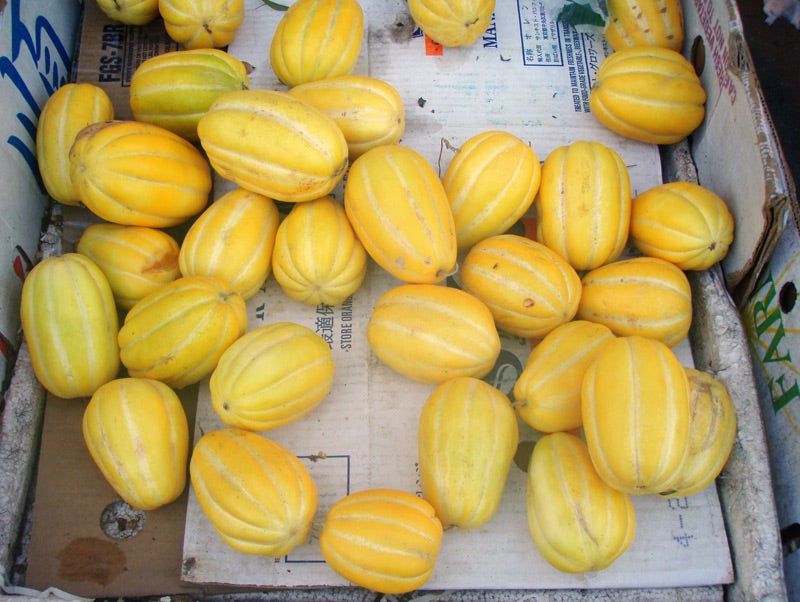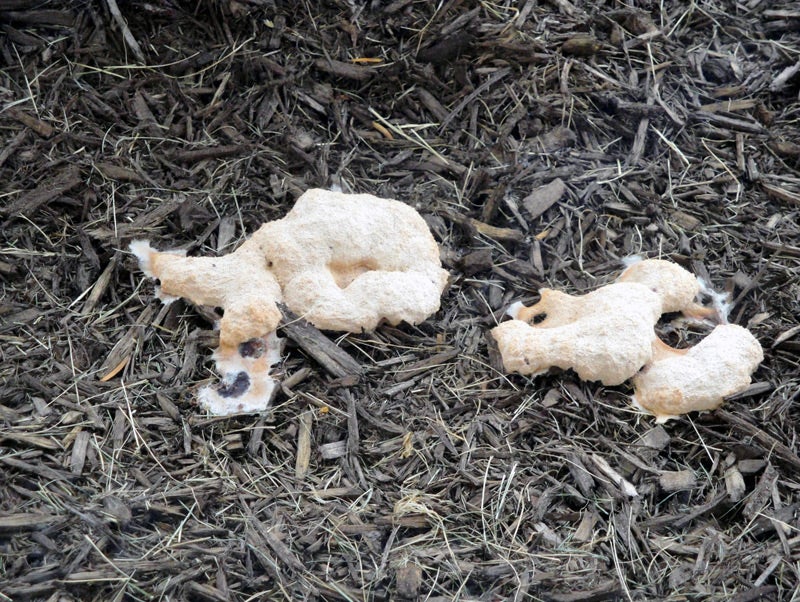The Wonderful World of Melons
Listen 00:52:58Call it a cantaloupe, a muskmelon or a netted melon, it’s a delight to eat, but difficult to grow. Mike McGrath, host of You Bet Your Garden, will delve into the wonderful world of mis-named melons! Plus your fabulous phone calls.
Question of the Week:
“I have a ‘flat earth’ plot in a community garden here in Shawnee, Kansas. My 7-year-old son Jack loves cantaloupe (aka muskmelon) and demanded that we try to grow some this year, so the pressure is on me to deliver. I haven’t tried to grow them before, but a couple of our other gardeners have told me they haven’t had any luck with them. Back around May 1st, we started some plants from seed under the lights I use to start tomatoes. Now what? A few websites say to use black plastic to keep the soil warm. Do you have any advice?
PS: Thanks for doing your show. I listen to the podcasts as soon as they are available. I also liked your tomato book so much I bought a copy for my mom. This year I grew so many tomato plants I had enough to give away to six friends and family members. I would never have attempted anything that elaborate without you egging me on. Thanks again!”
— Chris in Shawnee, Kansas
Is that a cantaloupe in your pocket? Or a muskmelon? »
-

Photo by Flickr user Anthony Easton
Highlights from show for June 6, 2015:
Hydrangea Troubles
Janet from Jenkintown, PA has in the past had issues with downy white scale on her hydrangeas. This year, the hydrangeas are, for the most part, healthy, but the scale has migrated to one of her blueberry bushes! In the area where her hydrangeas were growing, it’s nothing but shrubs and hosta and the like. When the problem first arose, she discovered that underneath her layer of mulch and soil was a layer of thick, black, plastic, which she had to remove. The blueberries, on the other hand are not mulched, and only one of the blueberries has the scale. Mike recommends that she try to raise the acidity of her soil there with a mulch of milled peat moss, covered with compost, and an organic acid fertilizer, such as Holly-Tone. Then, cradling the plants, try to blast the scale off of the plants with a high-pressure stream of water from your hose. “Believe it or not, in a situation like this, high pressure streams of water are the best pesticide. Think of a cartoon fire hose.”
-

Photo by Flickr user Maitri
Dog Barf Fungus
Dave from Chicago has set up three bins of shredded fall leaves and coffee grounds for composting when he noticed that at the top of one of the bins he saw a yellow growth! Mike notes that his method is slightly different from the traditional three-bin method, wherein you fill one bin, after some time turn it over into the second, then into the third, where you keep your finished compost. Dave’s bins are not made of wood, but from hardware cloth, providing great airflow for his compost. Dave also has an apple tree growing right above these bins, which regularly deposits all sorts of plant matter into the bins on its own, although it hasn’t borne fruit for a while. Mike believes that these bins are infested with “Dog Barf Fungus,” a type of “nuisance mold” related to the slime mold. It is more common in rotting wood, so it’s likely that some branches fell into the pile, giving rise to the fungus. The fungus is completely harmless, so Dave should take a pitchfork and make sure that the fungus is mixed more thoroughly throughout the pile, and maybe add some coffee grounds to get some nitrogen in there. “It might even make the compost more nutritious in the end.”
Featured Interview:
Mike speaks with author Linda Chalker-Scott about her new book How Plants Work: The Science Behind the Amazing Things Plants Do. This book is a great resource for gardeners who want to understand why and how plants do what they do. Mike clearly found a kindred spirit in Chalker-Scott’s organic methods for planting and caring for trees. She shed light on how tree roots bring in air and why it’s important to spread the roots of plants. .
Left Over Compost
Marissa in North Wales, PA is getting ready to get a raised bed for her new house, and has just gotten a whole bunch of compost to fill them. However, she’s got an awful lot left over. She wants to know what to do with the leftovers, and how to store it for next season. Mike explains to her the most important rule of gardening: “nobody gets to August and wishes they’d bought less compost.” Mike is concerned that she won’t have the bed ready until it’s too late, but she assures him that she’s building it as soon as she moves in, and that she’s even going to take the day off of work to build the bed. Mike recommends that she add pearlite to the soil, to keep it light, and to take it slow to build the beds. After all, the inside of the house is going to need a lot of work already, and if she’s working inside during the day, she only needs to work out there in the morning and the evening, when the sun is much more forgiving. Since she’s starting so late in the season, Mike also says to pick lots of plants that grow later in the season, and garlic and salad greens to grow during the winter and spring respectively. For this purpose, she should also add some metal hoops over the top to stretch row cover fabric over the top of it. “Then you can probably grow salad greens all winter long through the spring, and you’ll have really warm soil to plant in for next season.”
American Hornbeam
Rich in Philadelphia wants to know about an American Hornbeam planted in front of his office in Center City. Now, this tree was newly planted in early January and looks to be about twenty years old. Rich had used a tree spike fertilizer in the early spring and Mike appropriately chastises him for it. “I wish you hadn’t done that,” he says, “When we go walking through Fairmount Park and we see the trees, has nature come along and spiked them?” And if this is a commercial fertilizer, it’s probably full of chemical salts, which, the tree most certainly doesn’t need, considering how salty the soil was after this past winter. Rich notes that the tree has a lot of growth on it and it looks very strong, but the leaves are struggling. Rich has taken it upon himself to take care of this tree and mentions that he waters it every night, which Mike also chastises him for. “You don’t wanna be watering at night, and you don’t wanna be watering shallowly every day.” He says to instead, go out at least twice a week in the morning, drop a quart of water into the soil, let it settle, and then, after a few hours, repeat until there’s a good gallon of water surrounding the tree, and only when there’s no rain. Get a liquid fish and seaweed mix, put a little bit of that in the water. There’s not enough room for compost, so that’ll have to do for nutrients. He also says to remove the mulch from around it so the root flare is exposed, because right now it’s too crowded. “Here’s the deal, we don’t know really what situation it’s in,” he says, “It seems like an overly large tree for this space; to me they should have put in a sapling or busted up more concrete.”
Safe Soakers
Marianne in Orange, MA, two hours west of Boston wants to get a new hose. She has finally found a hose that is lead free and suitable for potable water, and wants to find a soaker hose that isn’t made from recycled tires, or anything else that might cause health problems down the line. Mike has also recently been researching garden hoses to find cleanly-made hoses, and the ones that he’s found have been very durable and work very well for him. Now, if Marianne can’t find any cleanly-made soaker hoses he recommends going out and buying some drinking-water-safe hoses on sale, laying them out on a driveway, taking an ice pick or an awl, heat it up with a lighter, and then make a series of holes, six inches apart in a line. This is most definitely a job for two or more people! It won’t be too hard to find a cap for the other end of the hose. Marianne is concerned about the water pressure in the hose, that it might burst if not enough water can escape through those holes, and that poking these holes might compromise the safety of the hose. Mike points out that there are herbicides in our rainwater, and that she won’t be able to get to 100% regardless. He also points out that the safety should not be compromised, and that if there is an issue with pressure, she would certainly be able to fine-tune it to her liking. “Thank you for thinking so much about trying to have a clean environment around.”
WHYY is your source for fact-based, in-depth journalism and information. As a nonprofit organization, we rely on financial support from readers like you. Please give today.

